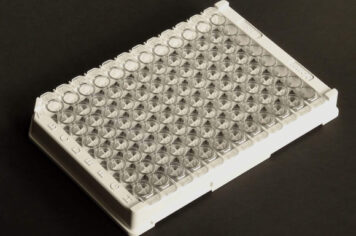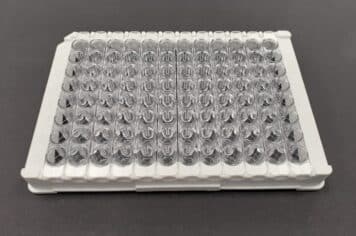No products in the cart.
Poly-L-Arginine Coated Surface shows a high density of groups α-amino, α-carboxyl and guanidino that are able to react through electrostatic and stereospecific bonds.
Poly-L-Arginine Coated Surface is a surface with physically adsorbed poly-L-Arginine: the monomeric L-Arginine chain shows a high density of groups:
- α-amino
- α-carboxyl
- guanidino
these groups are able to react through electrostatic and stereospecific bonds.
The polystyrene optical features don’t change, allowing the modified surface to be used as a valid tool to carry our biological tests.
Examples of applications for Poly-L-Arginine Coated surface
- interactions with serino proteases
- interactions with maturation promoting factors
Biomat Poly-L-Arginine Coated Products
Poly-L-Arginine Coated Surfaces main features
Biomat Poly-L-Arginine Coated products have the following characteristics:
- Ready to Use
- Manufactured under ISO:9001 guidelines
- All lots are tested for uniformity and reproducibility
- Certificate of Quality is released for every lot
- For Research Use Only
Also, Poly-L-Arginine Coated Products ensures:
Uniformity
The Poly-L-Arginine Coated Products show a CV% less than 5 when used as a catcher of NHS-biotin in an ELISA format, using Streptavidin-HRP as detector and TMB as substrate.
Storage and Stability
The Poly-L-Arginine Coated products, if unopened, are stable at 2 – 8 °C until the expiration date printed on the label. If opened, store in closed pouch with desiccant and use within the expiration date.
Poly-L-Arginine Coated Microplates Specifications
Coating
Poly-L-Arginine is coated using 200 μl/well.



